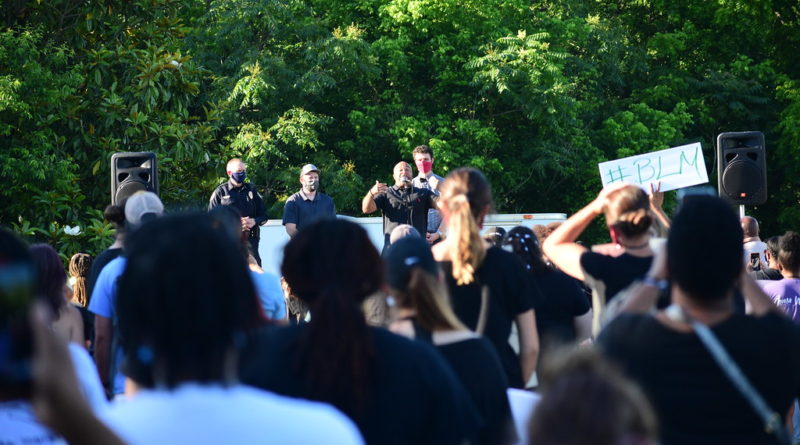Calls for justice: Faculty and students reflect on recent George Floyd protests
University of Dayton students and faculty share their experiences about recent George Floyd protests across the nation. Photo of George Floyd protest courtesy of Flickr.

Kaitlin Lewis
News Editor
Several University of Dayton faculty members and students took action as protests broke out nationwide in response to the death of George Floyd.
The first protest in Dayton started at about 11:30 a.m. Saturday May 30. Crowds gathered at the courthouse to hear from speakers before marching into the Oregon District towards US 35.
Sr. Laura Leming, Sociology Professor at the University of Dayton, chose to participate at a distance with her fellow Marianist sisters Gabby Bibeau and Emily Sandoval.
Leming said her house decided to not take any unnecessary risks in exposing themselves or others to COVID-19, so the three sisters stood at their corner of Main Street with homemade signs.
“This kind of blatant police violence and total disregard for people of color needs to be protested and stopped,” Leming said. “As a university community, we need to be a part of the re-thinking and the work to re-structure.”

Photo of Leming’s sign that she held at the protest, courtesy of Leming.
“As Catholics, we claim to be pro-life but often seem to focus only on life in the womb,” Leming continued. “It has to be a commitment to the whole thing.”
The protests continued into Saturday evening with a march from Courthouse Square to the Dayton police station.
Dr. Bobbi Sutherland, a history professor at UD, was a part of the crowd. According to Sutherland, the scene walking towards the station was “terrifying,” even though the protestors were walking peacefully.
“As we marched cops lined the streets heavily armed, in riot gear, pointing guns,” Sutherland said. “People were yelling, for sure, and they had choice words for police. But no one threw anything or touched an officer that I could see. And then suddenly they threw a bunch of tear gas.”
Sutherland said that after getting hit with tear gas, she along with part of the crowd decided to stand further back from the station.
As the evening went on, and the city-wide curfew set for 9 p.m. drew closer, police started “closing in” on the protestors and used tear gas once again to force people to disperse. Sutherland left around 8:40 p.m. in order to make it home before curfew.
Sutherland also attended a sit-in protest on Monday June 1 in front of the Walmart Supercenter on Pentagon Boulevard, Beavercreek.
The Beavercreek Walmart is where John Crawford III was shot and killed in 2014 by a police officer who mistook Crawford’s BB gun for a rifle. The sit-in began at 4 p.m. and similar to Sutherland’s experience on Saturday, the police again used tear gas as a way to move peaceful protestors out of the street.
More unique to the Monday protest was that Sutherland witnessed a white couple in a pickup truck angrily yelling at protestors as they drove down the street. The same couple later returned that night to do the “Nazi salute.” Sutherland also said there was a white man who walked around visibly armed and approached protestors asking if they “lived in the ‘Creek.’”
Also in attendance on Monday was UD senior Maya Smith-Custer, a senior international studies major.
Smith-Custer said she also witnessed the police using tear gas to move protestors off the street, which prompted some protestors to throw the canisters back at the officers. While she did not interact personally with any police at the protest, she did speak on how the officers treated the crowd as a whole.
“In my opinion, their attitude towards the protestors changed after the news coverage left,” Smith-Custer said.
Both Smith-Custer and Sutherland witnessed police officers taking a knee with the protestors, a sign of solidarity seen in many cities by law enforcement.
Smith-Custer described it as a way to “placate” the crowd.
Sutherland said she attended both protests because she could no longer remain silent on the matter.
“White silence is violence,” Sutherland said. “We cannot let our black brothers and sisters be left to do this alone. And, as an adult, I feel like I need to be there to document and record what happens, as young people are so often disbelieved.”
Some UD students participated in protests in their home cities as well.
Jordyn Mitchell, a 2020 UD graduate and former president of the Alpha Kappa Alpha sorority, the first historically black sorority, attended a protest in Cincinnati, Ohio, Monday, June 1.
Mitchell described the protest as peaceful and said that protestors knelt for 9 minutes in front of the Hamilton County Courthouse “in solidarity with George Floyd and our brothers and sisters protesting in Minneapolis.”
“As a black woman in America, I should not be a threat to police based on the color of my skin,” Mitchell said. “I should not have to live in a world where my father, mother, sister, cousins, could die at any moment because they were living while black.”

